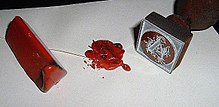Secret Cabinet Office
The Secret Cabinet Chancellery in Vienna was probably the best known and one of the most efficient “black chambers” , whose task in the 18th century was to read mail secretly. In the course of time, the deciphering of encrypted messages and even the falsification of the information, i.e. the disinformation of the recipient , became increasingly important .
The Secret Cabinet Chancellery was set up in 1711 as a decryption and forgery chamber in the Stallburg , a side wing of the Vienna Hofburg . As a camouflage, her name was changed several times to "Secret Numbers", "Numbers Secretariat", "Cabinet Secretariat", "Visitation and Interception Business" and finally "Secret Cabinet Chancellery". It experienced its heyday around the years from 1730 to 1760, when many competent experts in forgery and deciphering worked around the clock. Their task was routinely to open mail, to melt seals for this purpose , to read letters, if necessary copy them off or even to forge them, to reseal the mail, to seal it and to put it back into the mail service. This was done in a highly professional manner and under great time pressure so that the delivery of the letters was not noticeably delayed. The employees of the Secret Cabinet Chancellery were well paid and often received imperial recognition in the form of honors, medals and promotions. At the time, the Vienna Secret Cabinet Chancellery was considered the most efficient of its kind in all of Europe and thus the world.
The cabinet office was dissolved as a result of the political upheaval in Europe in the revolutionary year of 1848 .
literature
- Friedrich L. Bauer : Deciphered Secrets. Methods and maxims of cryptology. 3rd, revised and expanded edition. Springer, Berlin et al. 2000, ISBN 3-540-67931-6 .
- Siegfried Beer : The intelligence services in the Habsburg monarchy. In: SIAK-Journal. Journal of Police Science and Practice. Vol. 3, 2007, pp. 53-63, doi : 10.7396 / 2007_3_F .
- Manfred Fuchs: The Austrian secret service. The second oldest trade in the world. Ueberreuter, Vienna 1994, ISBN 3-8000-3502-2 .
- David Kahn : The Codebreakers. The Story of Secret Writing. 9th printing. Macmillan, New York NY 1979, ISBN 0-02-560460-0 .
- Simon Singh : Secret Messages . The art of encryption from ancient times to the Internet. Carl Hanser, Munich et al. 2000, ISBN 3-446-19873-3 .
- Fred B. Wrixon: Codes, Ciphers & Other Secret Languages. From the Egyptian hieroglyphs to computer cryptology. Könemann, Cologne 2000, ISBN 3-8290-3888-7 , p. 592 f.
Web links
- The Secret Power of the Black Cabinets Retrieved: May 29, 2015.
- The story of the mail opening.Retrieved : May 29, 2015.
- Black Chambers.Retrieved May 29, 2015.
Individual evidence
- ^ Fred B. Wrixon: Codes, Ciphers & Other Secret Languages. From the Egyptian hieroglyphs to computer cryptology. Könemann, Cologne 2000, p. 37.
- ↑ Friedrich L. Bauer: Deciphered secrets. Methods and maxims of cryptology. 3rd, revised and expanded edition. Springer, Berlin et al. 2000, p. 75.
Coordinates: 48 ° 12 ′ 26 ″ N , 16 ° 22 ′ 2 ″ E

